During the first days after housing, it is important to stimulate sufficient feed intake. The hens should increase their feed intake as fast as possible and continue gaining weight (see figure 1).
Some useful recommendations:
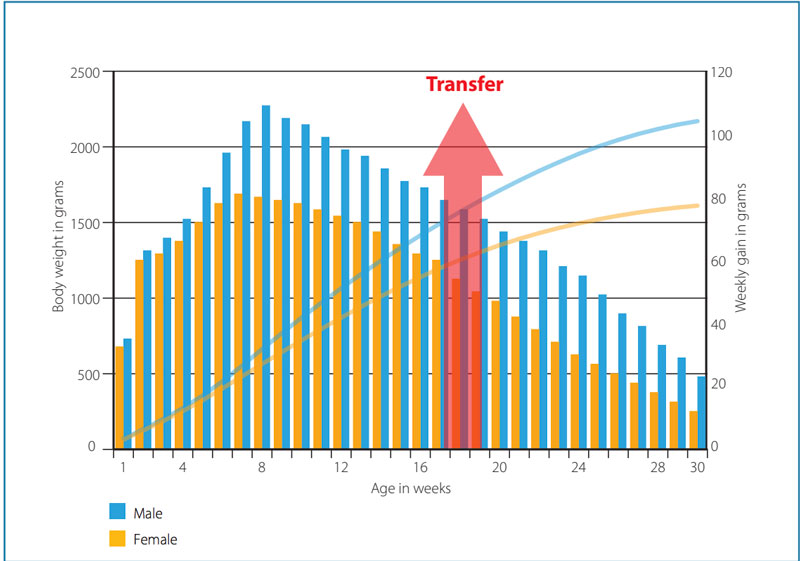
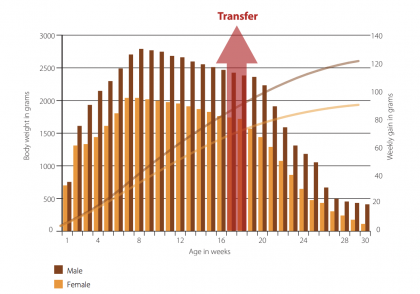



There are two main factors that stimulate the onset of laying in the flock:
In the absence of other stimuli, hens will begin to lay when they reach an appropriate body weight. However, the duration of the photoperiod can stimulate or delay the onset of lay as follow:
CHOOSE THE RIGHT STIMULATION AGE
How to choose the right stimulation age
Normally a flock should be kept with a stable photoperiod until light stimulation starts. If hens are in the weight range, a standard recommendation for standard production is 18 or 19 weeks of life.
However, this may vary according to:
The objective is to achieve as fast as possible an egg size of at least 50 to 52 grams, which is suitable for incubation. The goal is to reduce the number of unsettable eggs at the beginning of the production.
Never stimulate before 18 weeks of age.
TAKE THE NATURAL DAY LENGTH INTO ACCOUNT
The light program in open houses should take the natural day length at the stimulation age into account. Determine the light program during rearing as explained in section X. Stimulation should differ depending on the day length.
To achieve this goal, use the app: H&N lighting program
USE CORRECT LIGHT STIMULATION

FEED:
The birds need a good quality feed, with the structure and nutrient density necessary to suit their feed intake as well as provide their egg production, growing and maintenance requirements. Nutrient requirements in this phase increase rapidly so the feed intake of the birds should increase simultaneously. If not, the birds’ nutrient requirement will not be met and they will be forced to mobilize their reserves. This may lead to soft bones and potentially harm the bird for the rest of the laying cycle. Switching to a layer diet with more than 2.5 % calcium stimulates the birds to lay eggs. This feed phase aims
to cover the requirements to obtain the maximum egg mass. Check if feeders are also accessible for males, they are bigger than females and have big combs that could be an obstacle in some feeder lines.


WATER
Cool water of good quality should always be available with the required water flow. Continuously monitor the water quality. Water consumption is normally 1.5–2 times higher than feed consumption. It is highly recommended to monitor the water consumption for early detection of possible problems. Regular cleaning and flushing of the water lines as well as the supply tank is essential. Water consumption will clearly increase at 10–14 days prior to the onset of lay. During this period, the ovary and reproductive organs will develop, and water will be stored in the follicles of the ovary .
In aviary systems, keep an eye on levels where only water or feed is available. Pullets who don’t move from one to another level will emaciate and/or dehydrate. You could pick up some pullets and look if there is water/feed in the crop.
SPACE
The birds should have enough space, especially in hot climates. Important aspects are not only cm² of cage floor/bird, but the height of the cage, which is especially important for males to allow a normal mating, how many cm of feeder, and how many drinkers are available per bird. The temperature should be between 18–24 °C.

Points clés de l’utilisation des nids dans les systèmes sans cage:



The management in the rearing period is critical to success in the training for nest use:
The first 8 to 10 weeks post-hatch are critical to imprint the desirable behavior in our birds. Therefore, the importance of optimizing the rearing periods, particularly for birds going into cage free housing systems is extremely important. Environments with simple rearing systems are not cognitively stimulating or spatially complex enough to adapt pullets to navigate in aviary or even on floor system.
If we don’t provide perches or stimulate the pullets to jump on platforms in the rearing house, the chances to have a non-desirable % of floor eggs could be high.
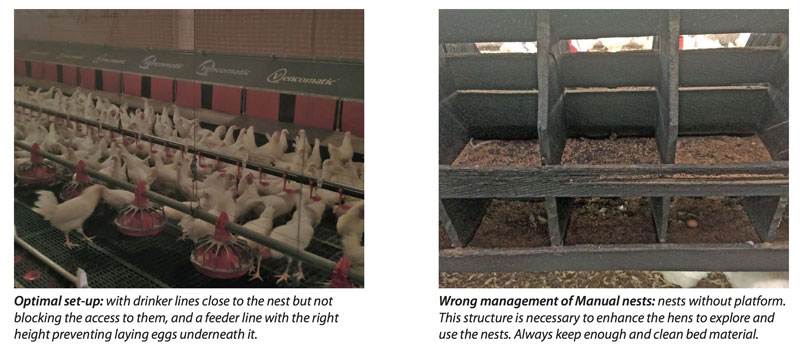
Rearing
Males and females should be reared together from the first day if they are going to be under natural mating conditions in production. Males from white breeders without comb treatment need to be separate until 7
to 8 weeks of age to select the sexing errors. Do not dub brown males unless you have problems with feeders/grills in rearing or production.
Don’t beak treat males (if you think you should beak treat them, ask H&N Technical service for advice). When is possible, males should be comb treated to avoid problems with feeder lines grills. This is a must when they will be housed in cages.
Males should be healthy and develop according to the standards as a predisposition for good mating behavior and good sperm quality. To achieve this, is important to follow the recommended stocking density, feeder and drinker spaces. Check weekly male’s body weight (always at standard) and uniformity (> 85 %). There are two critical periods when the body weight gain is extremely important and must meet the standard, the first is between 2 and 10 weeks of age, when the reproductive organs are developing and then, after light stimulation where is a fast growth of the testis. At 10 weeks of age and before transfer (light stimulation) from rearing to the laying house a selection of the males should be made to only keep males in good conditions.
Males with low body condition, leg problems, skeletal defects or bad feather cover will be sorted out. Furthermore sharp, hooked, short or uneven beaks should be selected since they can damage the females at mating. All time, the stage of development should match to the development of the females based on comb, wattle and feather as indicators: If their dominancy develops too early, the males are getting active before a sufficient number of females is sexually mature, and as a result the males start chasing females, over-mating occurs, males start fighting each other, females are getting damaged
and scared and as a final result, fertility is too low.
If their dominancy develops too late, the males will not become dominant over the females and will be scared to mate with them. The males can be physically well developed but will not mate because they think they are not able to do so and as a result, again fertility is too low.
Production
Males in natural mating should develop dominance over the females otherwise they will not mate. Therefore, is important to keep an eye on the condition of the males during the laying period and check weekly the
body weight development of the flock until week 30 and then biweekly.
Monitor carefully and permanently the sexual behavior of the flock and a good and even distribution of the males (especially important in the afternoon, during the mating period). An effort should be done to keep a good feather cover, otherwise females with naked backs will avoid males. Depending on environmental condition the mating ratio ranges between 8 and 10 males per 100 females. In controlled environment, usually 8–9 % are optimal. In open or slatted floors and hot climate 9–10 % are recommended. Not always more is better, more males than needed causes disturbance in the flock resulting in reduced fertility.
It is a good practice to start at 20 weeks with 9–10 % males in natural mating and 7 % in artificial insemination and proceed to select males with poor condition during production to achieve 8–9 % and 6 % respectively of good quality males at 25–28 weeks of age and during production (for male/female ratio in family cages please ask H&N Technical Service).
Vent colour is a good indicator of the male’s mating behavior, in an active male should be strong red and not pale and the variability of vent colour between males should be small. Males with pale vents and underweighted should be sorted out. In family cages, is critical to keep an eye on the males quality and behavior, because the decline in fertility could be faster than in floor systems. Every 2 weeks do fertility checks ad when necessary apply intra-spiking or spiking. Always keep a group of extra males in a pen (better if they are younger than the flock; more details in the male’s management Technical Tips.
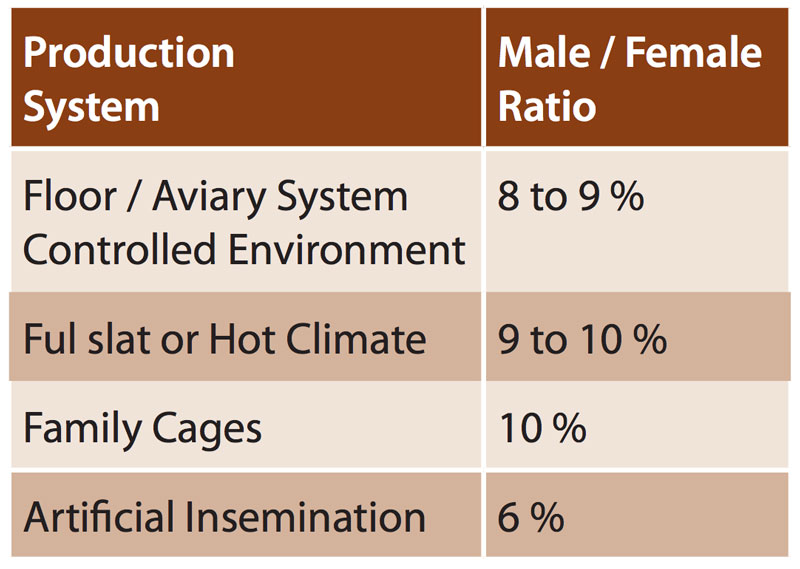
Fertility
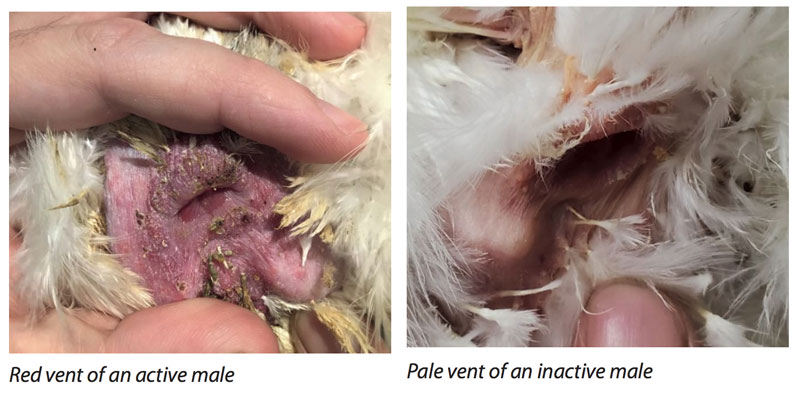
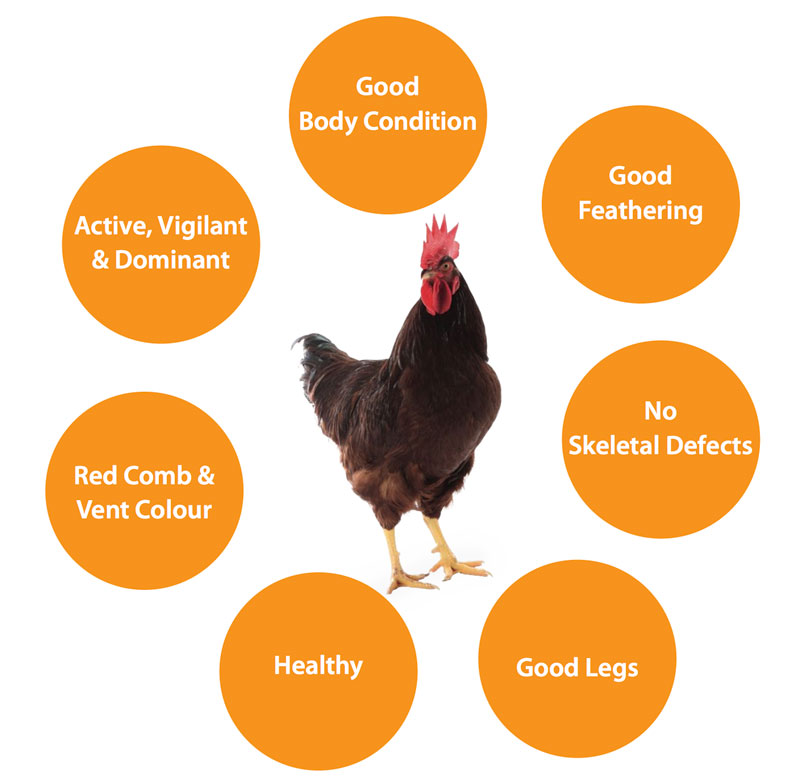
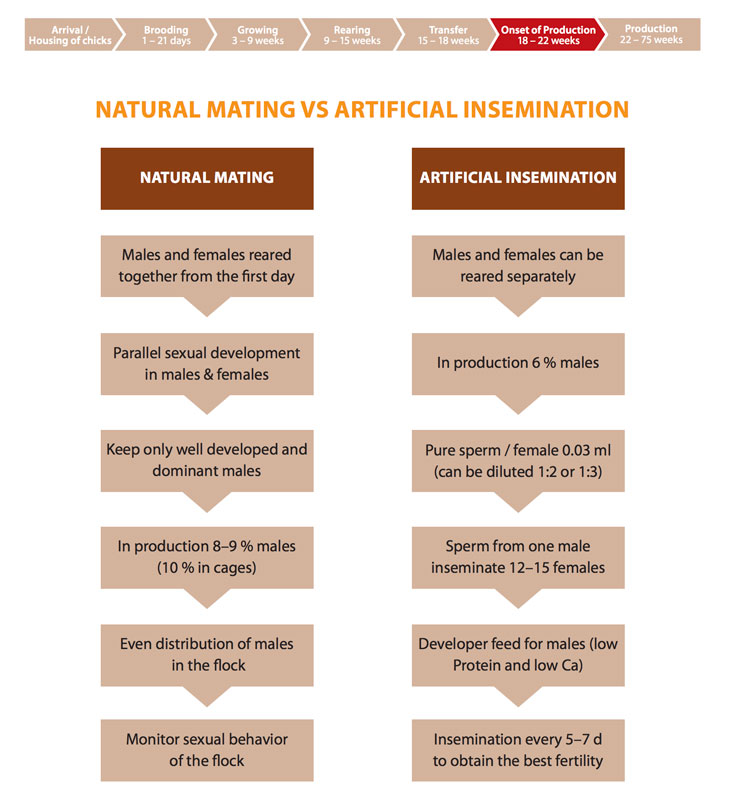
Monitoring production data is essential for timely intention in response to any issues that occur in the weeks between the first eggs and the production peak. Production data should be monitored daily or at least weekly.
% LAY
This should increase daily. During the first week, the increase may be small, but a bigger increase should be seen every day. In the middle part of onset of lay, the increase should be stronger, at least 2% per day and ideally close to 3%. Finally, in the last week, the increase should be close to 1% until the production peak is reached. The rate of increase cannot be monitored correctly if the eggs are collected at different times!
BODY WEIGHT
Increases could be a little erratic as not all the hens develop their reproductive system at the same time. However, body weight should never decrease, and a clear growth trend should be observed.
FEED AND WATER
As mentioned, consumption should increase every day. Water is the easiest parameter to monitor daily and is a critical management measure.
Female body weight and % lay until week 30
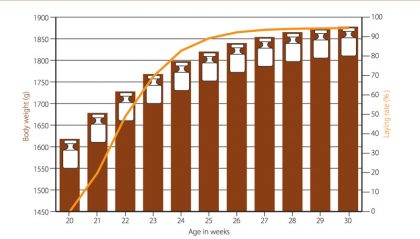

KEY POINTS
¡Bienvenidos! Su admisión está validada, por favor espere 2 segundos mientras la puerta de nuestra sala VIP se abre. ¡Por favor entre!
¿No tienes una cuenta?Regístrate ahora
